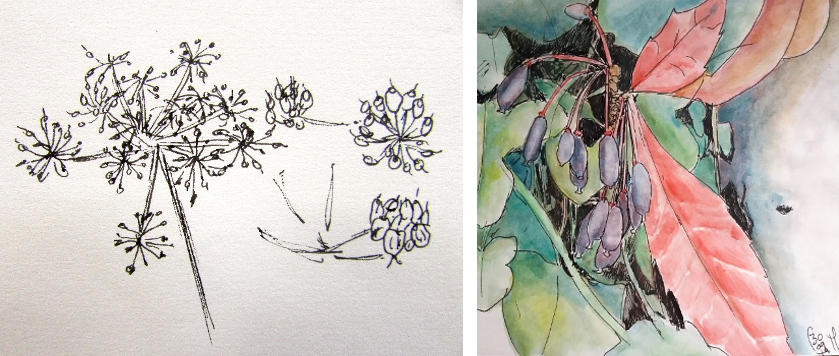I was first introduced to green sketching by Ali Foxon - on one of her Boggy Doodle walks at Tegg’s nose in Macclesfield (UK). Although boggy that day, it was not. It was an absolutely scorching day, week in fact; the ground was bone dry, the grass straw coloured, the sun was flattening every shadow, the hills looked exhausted in the haze and it was still the morning. As we set out on the parched dusty path together, Ali explained with enthusiasm her vision to help people reconnect to nature through simple observation of natural details and sketching for pleasure. The beauty of doodling is that you do not have to be good, or draw something perfectly, far from it. Just observe closely, sketch and enjoy the process: you will be amazed at how intricate and varied nature is.
Every now and again we stopped in the shade to draw hills, tree shadows, oak leaves, cow parsley, some simple grass with stunningly symmetrical features or delicate serrated leaves... It was a revelation to find everything so interesting. It suddenly dawned on me that all that time looking to improve my drawing I had seen but not actually looked properly. I was always searching for the perfect view – you know, “it’s probably a bit further on”…- as nothing seemed worth drawing “here”. But I had been wrong all along– quite the contrary, everything is worth drawing and paying close attention to. Suddenly there was everything to re-view, re-discover and properly appreciate. I love going for long walks, and being outside in general, I do enjoy nature immensely already, so I was immediately converted. That was 2018, sketchbook and pen have never left my pocket since.
I decided immediately to use nature sketching to advance my secret plan to become a better artist so chose to go further than just doodling, and work on improving my drawing and painting skills. Daily practice is essential and the session with Ali taught me that I needed to become a more diligent observer, so use different aspects of nature sketching to practice different areas of drawing. Starting with developing an eye for interesting composition using a view finder across a broad sweeping landscape and revealing hidden possibilities – using only line drawings you can practice focal points, shadows and tones. You can try squares of different sizes or thin strips, looking for dynamic layouts. You see contrast better too that way. I have recently purchased a couple of black ink brush pens to push myself to become bolder with shadows and strong contrasts - suddenly details in lighter areas jump out of the page and the dramatic angles of branches give new character to your drawing.
Flowers, leaves and plants help me develop an eye for details – I try to discipline myself to watch carefully first, looking for shapes and how they relate to each other. This also helps with relative size and angles, and that is when you realise how intricate nature can be - and you can go further and further with the level of detail you want to achieve and challenge yourself.
Although outdoor direct observation is best, you can keep going and draw nature at home too. I love picking up treasures on my walks for close study later: shells, pebbles, seed heads, branches and lichens - the latter are mesmerising, so intricate, structured and colourful, complete worlds in miniature - but you need a magnifying glass or to take a closeup photo to truly appreciate it all. Lichens also definitely deserve to be drawn in colour!
Finally, I want to learn to draw light. When sketching outdoors I take a few watercolour pens to do a wash, but use paints to render sun, reflections and weather better. I love the dappled effects of the sun through tree canopies on the ground and Autumn leaves against dark skies. I do take a lot of photos of dramatic clouds or twinkling sunlight on water. These are fleeting and temporary effects I really want to get right as they set the mood, record a feeling or a season. On a walk you can slow down and appreciate time passing and enjoy change; from this summer I will try and make a habit of noting down these observations together with my sketches so that impressions, scents and sounds are also recorded. In fact I have been make a eagerly waiting for snow all winter - ready to record and re-discover its soft shapes in subtle colours and quiet stillness but wasn’t very lucky in that respect in my area this year!
As you can see, I have been bitten by the nature sketching bug. My kind of nature journaling is also an art journey, it provides me with a kaleidoscope of subjects and ideas I will brave all weather for. With so many opportunities literally right on our doorsteps, I hope that you too will realise that everything is worth drawing – just keep a pen and a small notebook in your pocket.
You can find more of Laurence’s work on Instagram @laurencemenhinick.










